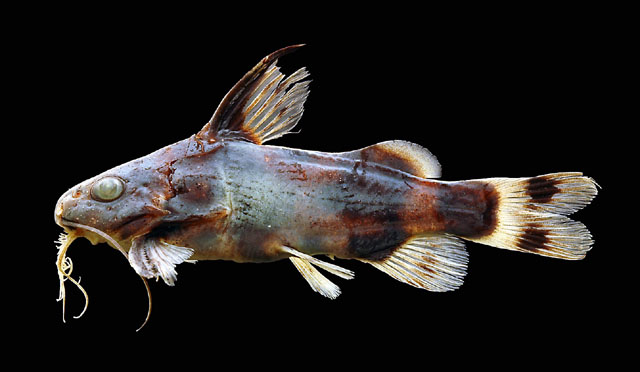|
Dorsal spines (total): 2-2; Dorsal soft rays (total): 7-7; Anal spines: 3-3; Anal soft rays: 8-8; Vertebrae: 35-35. Diagnosis: relatively small species, with a maximum standard length below 50 mm (Ref. 56332). Distinctive color pattern including a pair of dark patches on the caudal fin, one patch in the middle of each lobe; posterior margin of opercle with a bony spine (small in females, elongate in males)(Ref. 56332, 81251). Dorsal spine only serrated along posterior edge (Ref. 81251).
Description: body compressed; predorsal profile gently convex, postdorsal body sloping gently ventrally; head depressed and broad, rounded when viewed laterally, with a rounded snout margin when viewed dorsally (Ref. 56332). Skull roof lacks ornamentation; head covered with numerous small tubercles (Ref. 81251). Eyes large and ovoid, horizontal axis longest (Ref. 56332). Mouth inferior and crescent shaped (Ref. 56332, 81251), with lips plicate (Ref. 56332) and papillated (Ref. 81251). All teeth unicuspid; primary teeth 15-17 in a single row; secondary teeth 37-49 in irregular rows; tertiary teeth 16-18 in a single row (Ref. 56332). Mandibular teeth 14-16 in a single row (Ref. 56332, 81251), concentrated at mid-line (Ref. 81251). Premaxillary tooth plate wide with broad ventral shelf (Ref. 81251). Maxillary barbel long (Ref. 56332, 81251), slender and unbranched, extending to just beyond base of last pectoral-fin ray (Ref. 56332), 1.2 times HL (Ref. 81251), with no basal membrane (Ref. 56332, 81251). Mandibular barbels originate immediately posterior to lower lip in a transverse row, with primary branches, but secondary branches absent; inner mandibular barbels origin close to midline, extending to just beyond anterior margin of pectoral girdle, with 2-5 paired branches proximally and 2-4 longer unpaired branches distally; outer mandibular barbels originate lateral to inner mandibular barbels, extending to posterior margin of pectoral girdle, with 4-6 elongate unpaired branches; gill opening restricted to lateral aspect of head from level of the base of pectoral spine dorsally to level of the ventral margin of the eye (Ref. 56332). Each opercle with a single posterolaterally directed (bony) spine variously developed depending on gender and size of specimen (Ref. 56332), much larger in adult males (Ref. 81251). Humeral process elongated, narrow with a distinct lateral ridge, terminating in a sharp point (Ref. 81251). Dorsal fin located at anterior third of body, with spinelet, spine and 7 rays (Ref. 56332). Dorsal-fin spine long and slightly curved (Ref. 56332), smooth along anterior margin, small serrations on posterior margin (Ref. 56332, 81251). Adipose fin well developed, margin convex; anal-fin base located ventral to adipose fin, margin convex; pelvic-fin origin at vertical ventral to posterior end of dorsal fin base, pelvic-fin margins convex, tip of appressed fin just reaches anal-fin origin; pectoral fin with slightly curved, stout spine bearing large serrations; anterior spine margin with 8-17 distally directed serrations along entire length of spine, posterior spine margin with 8-13 proximally directed serrations along the entire length (Ref. 56332). Caudal fin deeply forked with 2 equal lobes; caudal peduncle longer than deep (Ref. 81251).
Coloration: in dorsal view, specimens appear banded with 6 dark patches over a lighter colored background; area between the nares dark brown; maxillary barbels dark brown to black, mandibular barbels cream colored; head with a light band between eyes and a light transverse collar at the level of the opercular spine, band lighter ventrally; large dark spot posterior to lighter collar continuous with pigmentation at base of dorsal fin and dorsal spine; small dark dorsal spot posterior to dorsal fin; small dark ventral spot posterior to pelvic fins; large dark patch from base of adipose fin ventrally to base of anal-fin rays; large dark spot covering most of caudal peduncle; ventral surface cream colored anteriorly with a series of thick, somewhat indistinct, dark bands separated by cream colored or lighter brown bands posteriorly; dorsal and pectoral spine very dark, rays blackish against translucent, milky membranes; adipose fin black basally with wide cream -colored band at distal margin; caudal fin milky colored with a pair of prominent black spots in dorsal and ventral lobes just anterior to fork of fin (Ref. 56332). |
